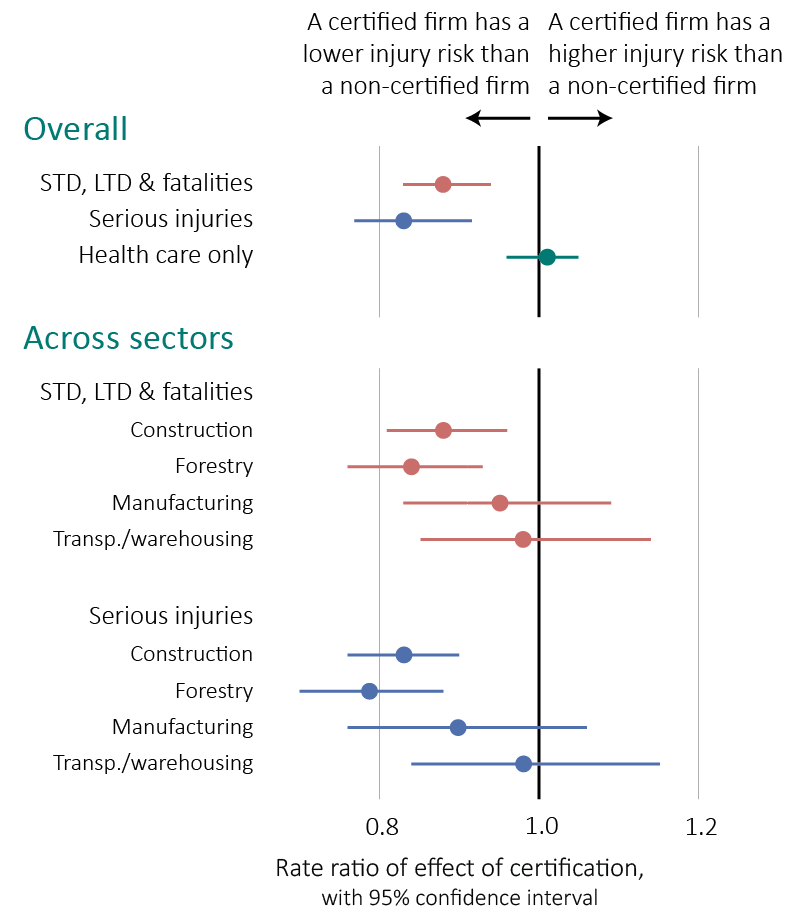Companies that sign up for a voluntary occupational health and safety audit commonly known as the Certificate of Recognition (COR) program have lower rates of serious injuries leading to time off work, according to a study by an Institute for Work & Health (IWH) researcher.
The study, conducted by the University of British Columbia (UBC)’s Partnership for Work, Health and Safety, compared injury rates between firms that took part in the province’s COR program and those that did not over a period from 2005 to 2012. It found COR firms had on average 12 to 17 per cent lower rates of serious injuries that resulted in time off work. No differences were found between the two groups when it came to injury claims that only resulted in health-care reimbursement (i.e. no-lost-time claims).
What’s interesting is the largest drops in injury rates were found in the most hazardous sectors, which were forestry and construction, notes Dr. Christopher McLeod, IWH associate scientist, and assistant professor and co-director of the partnership at UBC’s School of Population and Public Health. His study, commissioned by WorkSafeBC, is available on the Partnership for Work, Health and Safety website. McLeod notes that, due to the study design, he cannot say whether firms’ participation in the COR program resulted in the lower injury rates.

What we can say is that the COR audit process is effective at identifying firms with lower work injury risk,
he adds. But to say whether COR is facilitating change or driving the change, we would need a different study design, and that’s what we’re now laying the groundwork to do.
WorkSafeBC started using the Certificate of Recognition in 2003 as part of a pilot injury and disability prevention program in the construction sector. It was expanded to the oil and gas sector in 2004, and then to all industry sectors in 2006. Under the program, to receive a Certificate of Recognition, employers have to implement an occupational health and safety management system (OHSMS) and pass an audit of their health and safety practices. Employers with a certificate are eligible to receive a 10 per cent rebate on their WorkSafeBC base assessment. (Similar programs have since been introduced in other provinces, including Alberta, Ontario, Manitoba and Saskatchewan.)
For this study, McLeod and his team looked at claims data and firm data from WorkSafeBC. The team defined the intervention cohort as including all firms that became COR certified between 2003 and 2011, resulting in a cohort size of 5,106 COR-certifi ed fi rms. The control cohort included all firms registered with WorkSafeBC during that period that did not take part in the program; the size of this control group was 205,000 firms.
It’s well known that voluntary programs attract certain types of firms and not others. To account for the fact that real differences may exist between COR firms and non-COR firms in how they address health and safety issues, McLeod used what’s called a “difference-in-difference” analytical method. That is, he focused on the differences in injury rates between COR and non-COR firms both prior to the program and after the program—particularly the extent to which the difference widened between the two groups over the course of the study period. Looking at claims data for construction, forestry, manufacturing and transportation/warehousing sectors separately, McLeod found the largest reductions in injury rates (in COR firms relative to non-COR firms) in construction (averaging 12 to 16 per cent lower) and forestry (averaging 16 to 21 per cent lower). In contrast, only small reductions were found in manufacturing and none in transportation/warehousing.
Also, McLeod found little or no reduction when it came to injury claims that involved only health-care reimbursements and no lost time. “That suggests COR-certified firms are better at recognizing and controlling risks that lead to more serious or traumatic injuries, and maybe less so when it comes to more benign risks,” says McLeod.